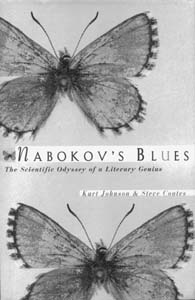![[Metroactive Books]](/books/gifs/books468.gif)
[ Books Index | San Jose | Metroactive Central | Archives ]
Extreme Lepidoptery
Playing catch-up with Vladimir Nabokov
By Sullivan Bianco
Beware! Hard symbol crash ahead:
"If I could persuade her to overcome her old-fashioned squeamishness and place simultaneously on palm and pulse (the hand alone would not be roomy enough!) the noble larva of the Cattelya Hawkmoth (mauve shades of Monsieur Proust), a seven-inch long colossus, flesh-colored, with turquoise arabesques, rearing its hyacinth head in a stiff 'Sphynxian' attitude."
Slurping up this quote from Nabokov's Ada, a book wherein one character anagrammatizes "insect" to "incest," a reader is tempted to see the author's passion pointed in a certain direction. It's far easier to read the physical matter of his novels as symbols. Rather than take them for their unrelenting senses-working-overtime processing of the entire world, interpreters would have them be pools of psychological revelation, poetic cloaks over a genius-fevered, self-denying cloaca of cosmopolitan compulsions. A new book avers both his seriousness and the contributions of scientific research to his mind-bending fiction.
Arriving on the heels of succulent Nabokov reissues (The Stories of Vladimir Nabokov, The Annotated Lolita and his awesome, unfilmable original screenplay of the latter) and remixes (Adrian Lyne's glazed, relatively humorless Lolita), Nabokov's Blues: The Scientific Odyssey of a Literary Genius is a gripping side trip. It scrapes away at an area discussed cursorily, if at all, in biographies of him: his exhaustive, lifelong love of lepidopterology (the study of butterflies) and his extensive study of a particular breed, the Blues, many of which now carry his name and the names of some of his characters.
For obvious reasons, Nabokov's achievements in novels, short stories, criticism and theory have overshadowed his contributions to understanding the butterflies and moths he studied, caught, drew, classified and dissected from boyhood. What emerges from the composite science-art portrait by co-authors Steve Coates and Kurt Johnson is an image of Nabokov and his fiction fused with his avid admiration for and variegated research into this tiny winged kingdom.
Nabokov's Blues' cogent mating of science and sinewy journalism--Coates is a New York Times editor and Johnson is an expert on Nabokov's breeds--is a terrific adjunct to the existing biographical material on him. Andrew Field's 1977 biography tends to skimp on the butterflies, but Brian Boyd's more enormous, more recent work (the two-part Vladimir Nabokov: The American Years and The Russian Years) processes the lepidopterological work better. Boyd, Coates and Johnson are all canny enough to include how butterfly-hunting trips took Nabokov into the territory and iconographic layouts that would find their way into his novels. Lolita's unforgettable car-window views of billboards--the descriptions of travel that may have caused a surge of sympathy in Jean Baudrillard--were inspired by the days he spent netting specimens in the western United States, and he continued to give readers hyper-real snapshots of America in Pnin and Pale Fire. "Nabokov once claimed he disliked travel unless it involved butterflies," Blues reminds.
Of the 14 chapters, about half (presumably the ones written by Coates) scrimmage to cover Nabokov's butterfly work historically alongside his mammoth literary oeuvre and his turbulent life bouncing from Russia to Germany to France to the U.S. and finally Switzerland. The other chapters take up the specific mantle of Nabokov's Blues butterfly study and are no less interesting. Indeed they are necessary to get a fuller view of Nabokov's rigorous taxonomy. Specifically, Nabokov's dissections of the clasping genitalia on Latin American Blues as well as his near-radical readings of breeds that appear similar have aided Kurt Johnson in reclassifying them. Johnson, working in cooperation with Hungarian Zsolt Balint and two Chilean entomologists, now notes a greater diversity in the species than had previously been acknowledged.
So, while "Notes on Neotropical Plebejinae" and "Sphingids Over Water"--two of Nabokov's "extreme splitting" scientific articles--aren't likely to buoy gentle readers on the can or the bus, Nabokov's Blues' summations offer a new, startling facet of a brilliant writer and his scientific legacy.
[ San Jose | Metroactive Central | Archives ]
Copyright © 1999 Metro Publishing Inc. Metroactive is affiliated with the Boulevards Network.
For more information about the San Jose/Silicon Valley area, visit sanjose.com.
![]()
 Insectuous: 'Nabokov's Blues' asserts the rigor of the author's butterfly writings.
Insectuous: 'Nabokov's Blues' asserts the rigor of the author's butterfly writings.
From the December 2-8, 1999 issue of Metro, Silicon Valley's Weekly Newspaper.